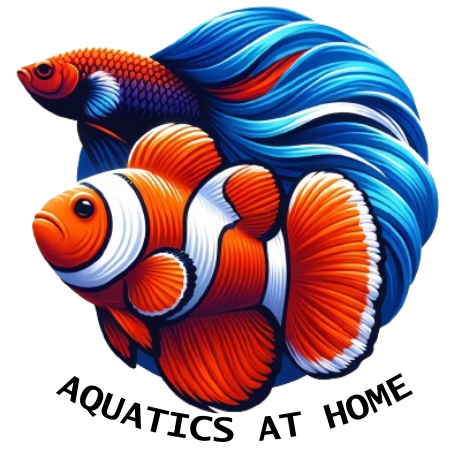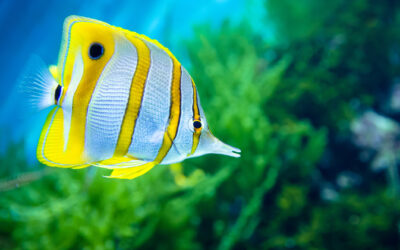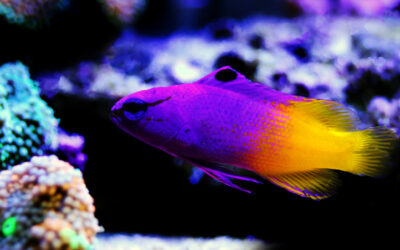Frogspawn coral is a unique and fascinating species with many interesting characteristics. I love the nobby little bubbles on the tips and the cool combos. If you add this to the fact that clownfish occasionally host these, I was in the moment I set eyes on one. In this article, we will delve into the physical characteristics, habitat, reproduction, care and maintenance, conservation efforts, and more, to fully understand this amazing coral.
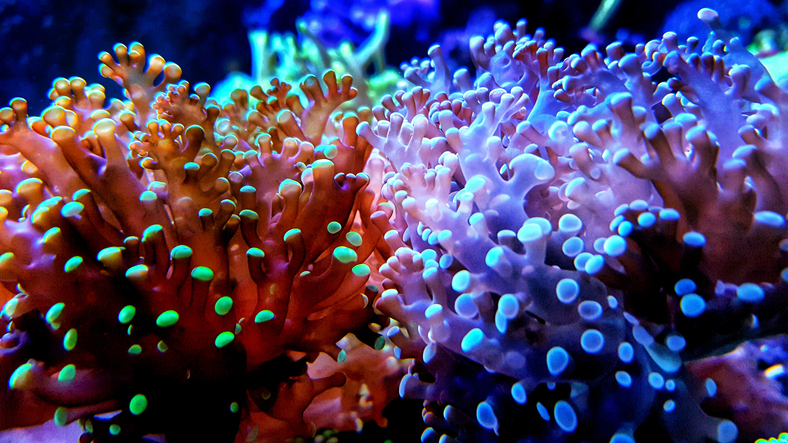
An Introduction to Frogspawn Coral
Frogspawn coral, also known as Euphyllia divisa or simply Euphyllia, is a member of the family Caryophylliidae, which are stony corals. It is named after its distinctive appearance, which resembles frog eggs or tadpoles. Frogspawn coral is native to the Western Pacific Ocean, where it is commonly found in shallow coral reefs and lagoons. You can also find it in almost every marine tank I’ve ever owned.
What is Frogspawn Coral?
Frogspawn coral is a species of coral that belongs to the family Euphyllia. It is named for its unique appearance, which consists of many small polyps clustered together to form a large, fleshy colony. The unique presentation of this coral is quite different from hammer coral when you find longer tentacles. Each polyp has eight tentacles surrounding its mouth, which it uses to feed on plankton and other small organisms.
The stony base often grows to develop new branches and new heads on each branch. They can get big and can handle decent water flow too. This isn’t a beginner coral, but if you have a little experience, this would be a good choice as you enter the realm of mid-tier technical care.
The Importance of Frogspawn Coral in Marine Ecosystems
Frogspawn coral plays an important role in marine ecosystems by providing habitat and food for a variety of marine creatures, including fish, crabs, and shrimp. It is also a source of calcium carbonate, which can help to build and maintain the structure of coral reefs.
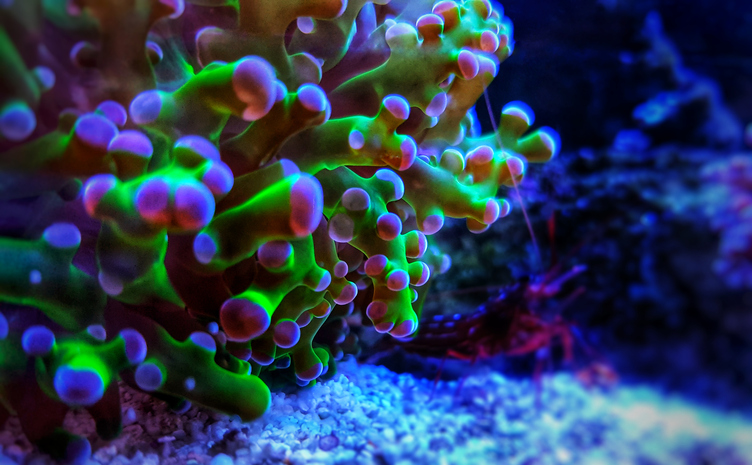
Back to Marine Aquariums
Aside from its ecological importance, frogspawn coral is also a popular addition to marine aquariums. Its unique appearance and ease of care make it a favorite among hobbyists. Please know that wild-collected specimens can have a negative impact on natural populations, so it is recommended to only purchase captive-bred specimens – ask your LFS if the coral was fragged or aquacultured if you want to do your part to keep our oceans safe.
In Science
In addition to its role in marine ecosystems and aquariums, frogspawn coral has also been the subject of scientific research. Studies have shown that it contains compounds with potential medicinal properties, including anti-inflammatory and anti-cancer effects. Further research is needed to fully understand the potential medical applications of these compounds.
Physical Characteristics of Frogspawn Coral
Frogspawn coral is a fascinating species known for its unique physical characteristics, which make it a beautiful addition to any tank. Add this to the color varieties available, and you have some really cool options to add some serious coral drip to your tank. Fragging frogspawn is pretty easy to do too, so if you run out of room, you can frag your lovely coral, and boom – no need to buy holiday gifts for your aquarium friends – they are about to get super cool coral.
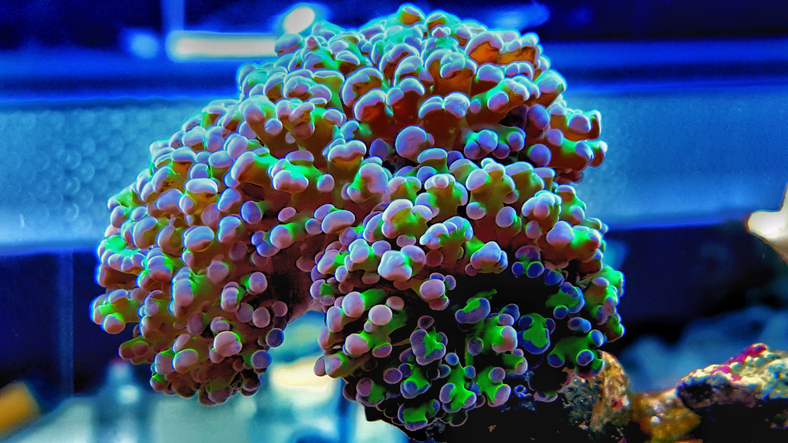
Color Variations
Frogspawn coral can come in a wide range of colors, including green, brown, pink, and purple. These colors can vary depending on the specific species of coral, as well as the lighting conditions of the tank. Some specimens also have fluorescent tips that glow under certain lighting conditions, adding to their beauty and intrigue.
The color of frogspawn coral can also change over time, depending on the health of the colony and the nutrients available in the water. For example, if the coral is not getting enough nutrients, it may turn brown or lose its vibrancy. Conversely, if the coral is thriving in a nutrient-rich environment, it may become more colorful and vibrant.
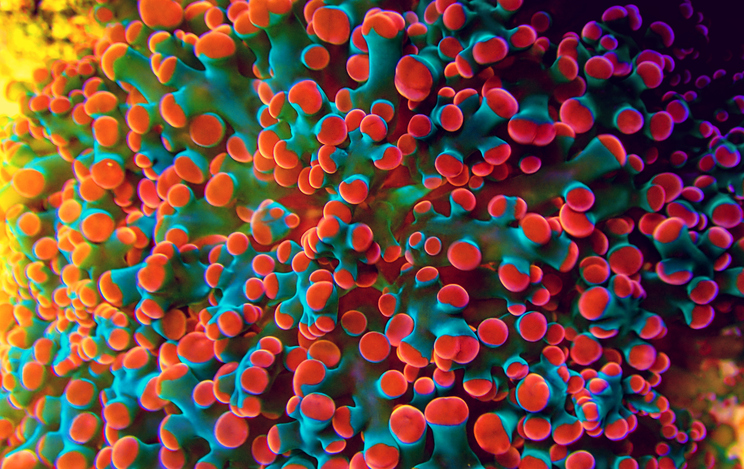
Shape and Structure
The structure of frogspawn coral can vary depending on the specific colony, but it typically consists of a central stalk with many small polyps branching off of it. Each polyp has a bumpy texture and is shaped like a small bubble. When the coral is healthy and thriving, the polyps will extend outwards, creating a dense, fleshy appearance.
The shape and structure of frogspawn coral can also change over time, depending on its growth patterns and the tank’s conditions. For example, if the coral is not getting enough light, it may grow in a more compact, bushy shape. Conversely, if the coral is getting plenty of light and nutrients, it may grow in a more open, branching shape.
Size and Growth Patterns
Frogspawn coral colonies can vary in size, with some growing up to a meter in height and width (but you have to have a pretty gigantic tank to sustain such a massive coral). The growth rate of the coral is highly variable, depending on factors such as water temperature, light exposure, and nutrient availability. It is not uncommon for healthy colonies to double in size over the course of a year.
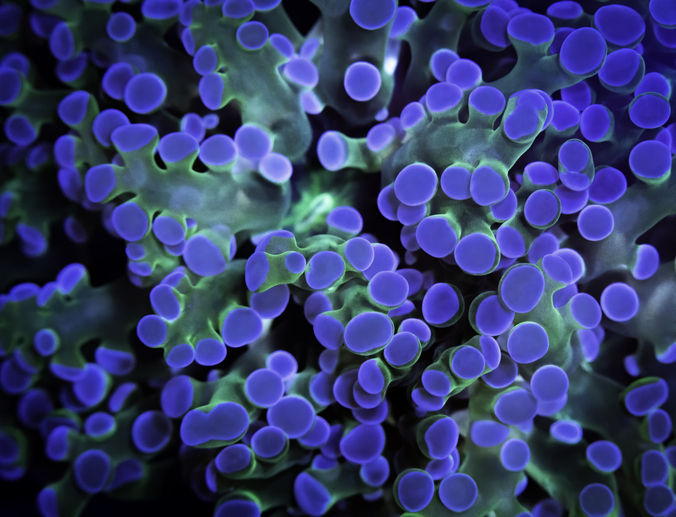
I’ve had some frogspawn corals grow incredibly quickly, and others grow at a very slow rate just from poor placement, so watch your coral closely and make adjustments to give it every chance possible to thrive in your tank.
As the coral grows, it may also change in shape and structure, as mentioned above. Additionally, the growth patterns of frogspawn coral can be influenced by other factors, such as the presence of other coral species in the tank. For example, if the coral is growing in close proximity to other species, it may grow in a more compact shape in order to compete for space and resources. Frogspawn are pretty aggressive too – their sweeper tentacles can get really long – and they are armed for battle. Give this coral plenty of space so it can grow into the space.
In any case – whether you are a seasoned aquarium enthusiast or a beginner, this coral is sure to add beauty and intrigue to your tank.
Habitat and Distribution
Natural Habitat
Frogspawn coral is a beautiful and fascinating large polyp stony (lps) coral typically found in shallow reefs and lagoons. These areas provide the ideal conditions for the coral to thrive, including ample light and water flow. The coral prefers areas with moderate water flow and is often found growing on rocks or other hard substrates.
One interesting aspect of the natural habitat of frogspawn coral is that it often forms large colonies, with multiple individual coral polyps growing together in a single mass. These colonies can be quite striking, with the individual polyps extending their tentacles to capture passing plankton and other small organisms.
Geographic Range
Frogspawn coral is native to the Western Pacific Ocean, where it is found in waters ranging from the Ryukyu Islands of Japan to the Great Barrier Reef of Australia. This broad range of distribution is a testament to the hardiness and adaptability of this species.
Interestingly, frogspawn coral is also commonly found in home aquariums worldwide, where it is prized for its striking appearance and ease of care. If your tank is suitable, I would recommend giving this coral a try – if you are like most who have frogspawn in their tanks, you will likely enjoy the movement and color of this unique and attractive coral.
Environmental Factors Affecting Distribution
As with all living organisms, frogspawn coral’s distribution can be affected by a number of environmental factors. These include water temperature, salinity, light exposure, and nutrient availability. Changes in any of these factors can impact the growth rate and health of the coral and can even lead to death in extreme cases. In some more extreme cases, frogspawn corals will eject their heads. If this occurs, contact your lfs, bring a water sample in, and take plenty of photos of your set up so you can figure out what’s going on.
For example, if the water temperature in a particular area becomes too high, the coral may experience stress and begin to bleach, which can ultimately lead to death. Similarly, if the water becomes too nutrient-rich, it can lead to an overgrowth of algae, which can compete with the coral for space and resources.
Despite these challenges, frogspawn coral has proven to be a resilient species, capable of adapting to changing environmental conditions. This adaptability is likely one of the reasons why it has been able to thrive in such a wide range of geographic locations.
Reproduction and Growth
Sexual Reproduction
Frogspawn coral reproduces sexually, with colonies releasing eggs and sperm into the water column. Fertilization occurs externally, and a planktonic larval stage follows, during which the coral settles onto a suitable substrate and begins to grow.
During the larval stage, the tiny coral polyps are at the mercy of ocean currents and other environmental factors. Many do not survive to reach adulthood, but those that do can live for decades or even centuries.
Once settled, the coral polyps begin to form a hard, calcium carbonate skeleton. Over time, this skeleton grows and branches out.
Asexual Reproduction
In addition to sexual reproduction, frogspawn coral can also reproduce asexually by budding new polyps from the existing colony. This can result in the formation of new colonies, which can grow and thrive independently of the parent colony.
Asexual reproduction can be a useful strategy for frogspawn coral, as it allows the colony to quickly expand its range and increase its chances of survival. However, it can also lead to overcrowding and competition for resources, which can be detrimental to the health of the colony.
Factors Influencing Growth Rates
Several factors can impact the growth rate of frogspawn coral, including water temperature, light exposure, water flow, and feeding frequency. Optimal conditions for the coral will vary depending on the specific colony and the surrounding environment.
Water temperature is a particularly important factor, as frogspawn coral thrives in warm water environments. If the water temperature drops too low, the coral may stop growing or even die.
Light exposure is also crucial, as frogspawn coral relies on photosynthesis to produce energy. Too much or too little light can be harmful to the coral, so finding the right balance is key.
Water flow is important for bringing nutrients and oxygen to the coral, as well as carrying away waste products. However, too much water flow can damage the delicate coral polyps.
Feeding frequency can also impact the growth rate of frogspawn coral. While the coral can produce its own food through photosynthesis, it also benefits from regular feedings of plankton and other small organisms.
Care and Maintenance in Aquariums
Ideal Tank Conditions
Creating a stable and consistent environment is crucial for the health of your frogspawn coral. This includes maintaining stable water temperature, salinity, and pH levels. It is recommended to keep the water temperature between 75-78 degrees Fahrenheit, salinity between 1.023-1.025, and pH levels between 8.1-8.4. In addition to these factors, providing adequate water flow and high-quality lighting is also essential. Frogspawn coral thrives in moderate water flow, and lighting should be provided for 8-10 hours a day.
Feeding and Nutrition
Frogspawn coral is a photosynthetic organism that obtains much of its nutrition from its symbiotic relationship with zooxanthellae, a type of algae. However, it also requires additional feeding to maintain optimal health and growth. This can include feeding with small pieces of shrimp, fish, or other seafood or providing liquid coral food supplements. It is recommended to feed your frogspawn coral once or twice a week, depending on its size and growth rate.
Common Diseases and Treatments
Like any living organism, frogspawn coral can be susceptible to a variety of ailing conditions. One of the most common issues is coral bleaching, which is caused by stress due to changes in water conditions or lighting. To prevent this, maintain stable tank conditions and avoid sudden changes.
Other common diseases include tissue necrosis and flatworms. Treatment options can include:
- Adjusting tank conditions.
- Targeting infections with antibiotics or other medications.
- Removing affected areas of the coral if necessary.
- Siphon out visible flatworms and try using flatworm exit
Maintaining a healthy and thriving frogspawn coral requires proper care and attention. By providing ideal tank conditions, feeding and nutrition, and addressing potential health issues, you can ensure that your coral will be a beautiful addition to your aquarium for years to come.
Conservation and Threats
Frogspawn coral is a beautiful and important species that plays a crucial role in the health of coral reef ecosystems. While it is currently not listed as endangered by the International Union for Conservation of Nature (IUCN), it is still vulnerable to a range of threats that can have a negative impact on its health and distribution.
Current Conservation Status
Despite not being classified as endangered, conservation efforts are still necessary to ensure the long-term survival of frogspawn coral populations. This includes monitoring populations and habitats, as well as implementing measures to reduce human-induced threats like the over-harvesting of coral reefs.
Human-Induced Threats
Human activities such as overfishing, pollution, and coastal development can all have a negative impact on the health and distribution of frogspawn coral populations. Overfishing can disrupt the balance of the ecosystem, leading to the loss of important fish species that help to maintain coral reef health. Pollution can also have a devastating effect on coral, as it can cause coral bleaching and disease. Coastal development can lead to the destruction of coral habitats, as well as increased sedimentation and nutrient runoff, which can smother and kill coral colonies.
One of the most significant threats to frogspawn coral, however, is coral mining for building materials. This practice involves the removal of entire coral colonies from their natural habitats, which can have a devastating effect on local coral ecosystems. Coral mining not only destroys coral habitats but also disrupts the balance of the ecosystem, leading to the loss of important fish species that help to maintain coral reef health.
Climate Change and Its Impact on Frogspawn Coral
Climate change is another major threat to the health and survival of frogspawn coral colonies. Changes in ocean temperature, acidity, and circulation patterns can all impact coral growth and survival, potentially leading to the extinction of entire populations.
As ocean temperatures continue to rise, coral bleaching events are becoming more frequent and severe. Coral bleaching happens when coral polyps eject the algae that live inside them, leaving the coral white and vulnerable to disease. If the coral does not recover quickly, it can die.
Acidification of the ocean is also a major concern for coral reefs. As the ocean absorbs more carbon dioxide from the atmosphere, it becomes more acidic, making it more difficult for corals to build their calcium carbonate skeletons. Increased acidity can lead to slower growth rates and weakened coral structures, making them more vulnerable to damage from storms and other disturbances.
Changes in ocean circulation patterns can also have a significant impact on coral growth and survival. Strong currents can damage coral colonies, while weak currents can prevent the delivery of nutrients and other important resources.
Overall, it is clear that frogspawn coral faces a range of threats, both human-induced and natural. Conservation efforts are crucial to ensure the long-term survival of this important species and the coral reef ecosystems it supports.
Wrapping Up
The Significance of Understanding Frogspawn Coral
Frogspawn coral is an important and fascinating species that play a crucial role in marine ecosystems. Its unique physical and biological characteristics make it a valuable subject for scientific study and conservation efforts. As threats to the species continue to mount, it is vital that we work to understand and protect this remarkable creature.
Future Research and Conservation Efforts
Future research and conservation efforts must focus on identifying and mitigating the various threats facing frogspawn coral populations, including climate change, pollution, and habitat destruction. By working together to protect this and other coral species, we can help to ensure a healthy and vibrant future for our oceans and the creatures that call them home.

About the Author
With decades of experience, James shares his extensive knowledge in aquatics through this website, covering a broad series of topics related to the pond and aquarium hobby. Aiming to guide both beginners and experienced hobbyists alike, his goal is to help educate aquatic enthusiasts for the long-term betterment of the hobby as well as the environment. Learn More >>
Exploring Butterflyfish Species for Marine Aquarium Enthusiasts
Disclaimer: This blog shares my personal experiences, research, and insights as an aquatics hobbyist. While I strive to provide accurate information, please consult a professional or your local fish store for tailored advice on your specific tank setup. Remember,...
Exploring Basslets for Your Marine Aquarium
Disclaimer: This blog shares my personal experiences, research, and insights as an aquatics hobbyist. While I strive to provide accurate information, please consult a professional or your local fish store for tailored advice on your specific tank setup. Remember,...
The Six Line Wrasse: A Comprehensive Guide to Care and Keeping
Disclaimer: This blog shares my personal experiences, research, and insights as an aquatics hobbyist. While I strive to provide accurate information, please consult a professional or your local fish store for tailored advice on your specific tank setup. Remember,...
